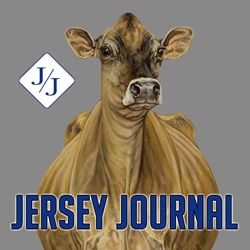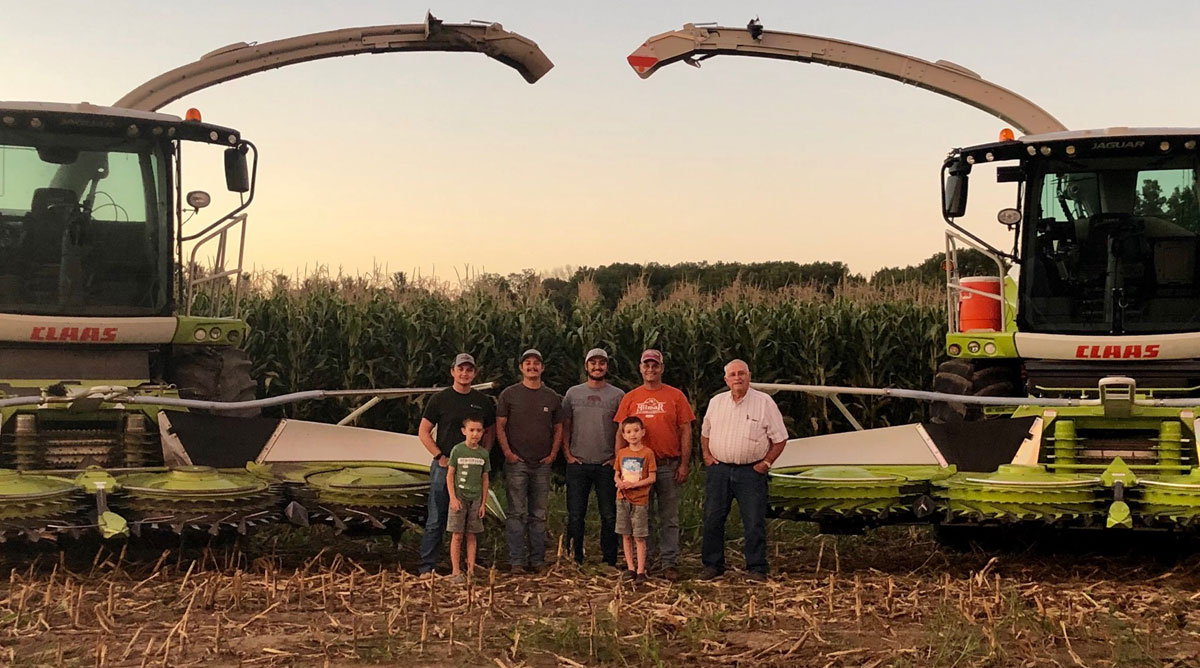Genetic Gain Founded on Registered Cattle at Sand Creek Dairy
At Sand Creek Dairy LLC, production has long been a priority. High production comes from marrying high-quality genetics with a high-quality environment.
“We attack production from both ends,” said Ethan Haywood, a sixth-generation dairy farmer who operates the dairy in Hastings, Mich., with his family. “We try to invest in the best genetics possible and then provide the optimal environment for them to express themselves.”
The effort has paid off as the Jersey herd at Sand Creek Dairy has ranked among the top 10 herds in the nation for at least one measure of production each of the past five years and regularly ranks among the breed’s best for genetic merit. The Haywoods have developed a strong market for excess dairy replacements and elite genetics and have been recognized in the World Forage Analysis Superbowl conducted during World Dairy Expo.
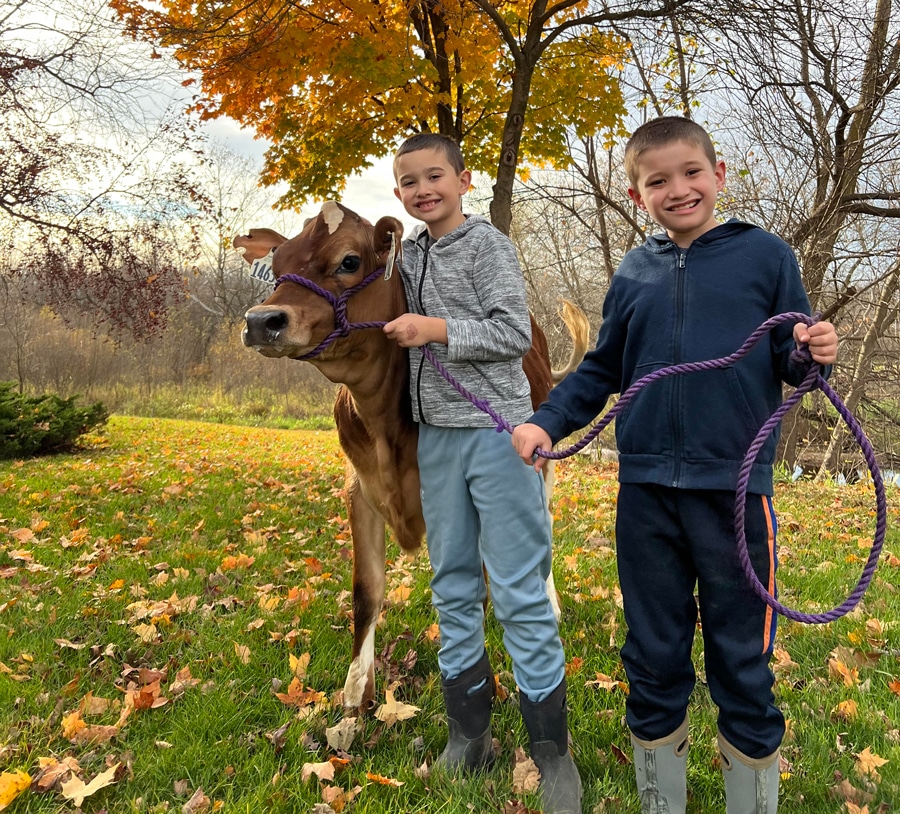
The Haywood family has proudly farmed for six generations. Larry and Ellen Haywood, the fourth generation, work alongside their son, Luke, and his wife, Renee, the fifth generation. They are joined as owners and managers by the sixth generation, Ethan and his wife, Elena, and Austin and his wife, Madison. Ethan and Austin’s brother, Devin, serves as a primary mechanic on the farm and younger siblings, Colton and Brenden look to continue the family’s dairy legacy. The Haywoods credit their success to their skilled team of 20-22 additional full-time employees.
Sand Creek Dairy milks 800 Holsteins and 400 Jerseys and farms 2,000 acres. The Jersey herd is enrolled on REAP and has a 2024 actual herd average of 22,794 lbs. milk, 1,156 lbs. fat and 853 lbs. protein on 252 cows. Nationally, the measures rank sixth for milk and protein and 10th for fat this year. The herd ranks #8 for genetic merit with a herd average JPI of +74 on 365 cows (December 2024).
Becoming More Brown
The Haywoods have been milking cows for about 100 years on land located between Grand Rapids and Kalamazoo. Sand Creek Dairy takes its name from the sandy soil that is characteristic of Barry County and the creek that runs through the property, where milk was cooled in cans in the early days.
While there have always been a few Jerseys on the farm, Holsteins and Brown Swiss were the primary breeds for many years. In the early 2000s, the Haywoods introduced 200 additional Jerseys to the milking string to increase components.
“Under Prairie Farms, we have a quota that is based on pounds of milk,” noted Ethan. “But we are also in the Mideast Federal Milk Marketing Order, so our pay price is reflected on pounds of fat and protein. Jerseys help us maximize the amount of fat and protein that is shipped within that quota.”
“For about 10 years, Jerseys ran in the pens with the Holsteins and were just expected to keep up with the Holsteins in production,” Ethan remarked. “We believe that allowed us to develop a very elite, high producing herd because they were under the same constraints. We were never concerned because they stuck up for themselves very well.
“We utilized a lot of sexed semen early on to expand that population,” he continued. “When we went through another expansion in 2017-2018, we bought a few loads of really good cattle from Pine-Tree Dairy (Marshallville, Ohio) and a pot load of nice springers from Avi-Lanche Jerseys because I was interning for the operation in Dalhart, Texas.”
Cattle were also sourced from consignment sales.
“My senior year of college, I spent a lot of time in class buying individual animals online through sales like the Northeast Jersey Classic, the Ohio Fall Production Sale, and other Jersey sales. At that point I wasn’t looking for IVF (in vitro fertilization) candidates, but rather solid, good-pedigreed, genomic-tested springers and heifers.”
More recently, elite individuals have been purchased through the All American Sale, the National Heifer Sale and the Pot O’Gold Sale. These animals have been flushed to increase their impact genetically.

A maternal line that has risen to the top is Sandcreeks Critic Chipster-P-ET, Excellent-93%. She has six lactations and a top record of 27,930 lbs. milk, 1,466 lbs. fat and 1,049 lbs. protein. She traces five generations back to a heifer the Haywoods purchased from a Canadian Jersey breeder in 2003.
“We identified ‘Chipster’ as special when we started genomic testing and did a lot of flushing on her,” noted Ethan. “We have done a lot of work with her daughters, granddaughters and now her great granddaughters. Her influence is present in over 100 females that have been born into our program and 20 bulls that have been sent to stud.”
The Value of a Certificate
For the Haywoods, the “why” for breeding registered cattle is founded on a desire to improve genetics.
“Genetics have always been important to use,” explained Ethan. “My dad and grandpa were early to adopt A.I. technology and are never afraid to invest in high quality semen so we can use the best bulls on the market. They began registering the cows for better record keeping and to be able to market high quality animals that had documented ancestry.”
“Data has begun to play a bigger role in this process,” he continued. “We aggressively use genomic young sires, so want to contribute that data back into the pipeline by registering their daughters. In that way, their lactation records and scores are recorded so we can continue to improve the breed and ensure the Jersey cow is competitive in today’s dairy market.”
The Breeding Program
Sand Creek Dairy uses sexed semen and beef semen for matings to create female replacements for the dairy, plus a little extra. Beef calves are picked up twice a week as day olds by a local buyer.
“We are creating 125-130% of our needs so we have some extra fresh cows to sell as replacements and can be really selective on the female side, which propels the speed of genetic gain,” Ethan explained.
“Between Holsteins and Jerseys, we are implanting about 700 embryos a year, and most of these are created using sexed semen.”
About 80% of heifers are implanted with an embryo on the first service. Sexed semen is used for the balance of heifer matings and subsequent heifer matings if they don’t settle with the embryo. Cows are implanted with embryos or bred with sexed or beef semen depending on genetic merit.
“Every cow and heifer is individually mated,” noted Ethan. “We keep five to eight bulls of each breed in the tank at a time and spread risk amongst different genomic young sires. We are not afraid to double back on a proven sire we really like, but probably 90% of our semen is from genomic young sires.”
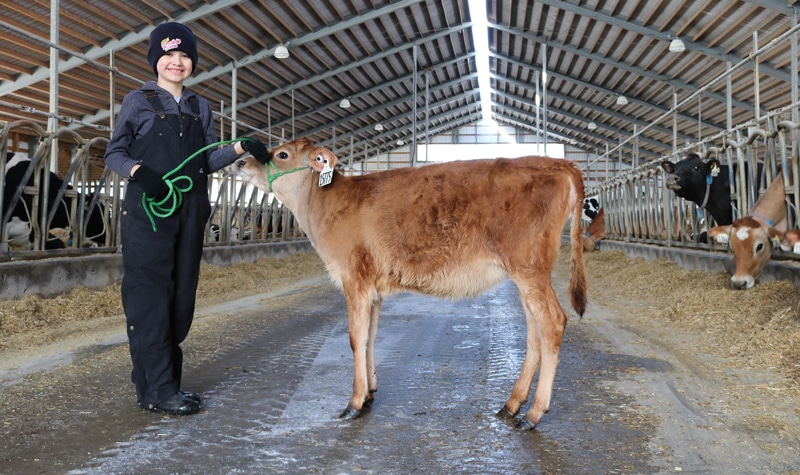
The Haywoods sell fresh cows to dairy producers across Michigan and the Midwest and occasionally consign high genomic heifers to the All American Jersey Sale, the National Heifer Sale and the Pot O’Gold Sale and special breeder events like the Decades of Dupat or Fun in the Sun series. Bulls have been placed in nearly every A.I. stud, exported to Nepal and Brazil and sold locally as herd sires.
“We look for opportunities to consign, but often that is determined by what sales are happening, when they are happening and what we have available,” said Ethan. “We try to sell heifers that are OPU (ovum pickup) ready and flush age so people can make use of them right away.”
Feed Quality Matters
The Haywoods have focused on feed quality to boost production. The operation is vertically integrated, which gives them control over the entire process, from seed to feed.
“Our in-house team and some part-time help handle everything, from planting to covering in the bunk,” Ethan noted.
The total mixed ration includes homegrown haylage and corn silage along with purchased soybean meal, wheat middlings, fats, canola, salts and minerals. Either ground corn or high moisture corn is included as well. Grinding is done on the farm by the Haywoods.
“We irrigate a lot of acres and plant all BMR (brown midrib) corn silage along with low lignin alfalfa,” remarked Ethan. “We focus on making digestible, high-quality feed. We can normally get five cuttings of hay a year when the weather cooperates. We chop all our own corn silage and haylage at pretty tight intervals to maximize quality and digestibility.”
“On the seed side, we are a distributor for Brevant seeds,” he continued. “Like the dairy side, we are not afraid to invest in the very best genetics and try to care for the crop and provide an optimal environment. Starting out with superior genetics and making that investment on the front side is important to us.”
The proof is in the pudding as Sand Creek Dairy has stood out among its peers in the World Forage Analysis Superbowl across a decade of competition.
“The forage superbowl is an opportunity for us to compare our feed quality on a year-to-year basis,” Ethan said. “This is the best feed around and we have been successful winning the haylage category multiple times, the BMR division a few times and the conventional corn silage category last year.
“It keeps us motivated to make sure we are trying new things and pushing the envelope as far as maximizing the quality of the feed that we are raising for our cattle.”
Facilities
Cows are housed in freestall barns bedded with recycled sand and fitted with rubber mats in most alleys and headlocks in every pen. Cows are milked in a double-20 parallel parlor that runs ‘round the clock. Hospital cows are milked in a double-six parallel parlor. Fresh cows are milked four times daily until about 50 days fresh and then dropped to three-times-a-day milking. A maternity and hospital barn is the newest structure on the place, built several years ago.
Heifers are raised on the farm until five months of age and then sent to a heifer grower on the other side of Hastings. Here they are bred or flushed using the same embryo transfer tech as the home farm. They come home four months confirmed pregnant.
Sand Creek Dairy harvests at least 90% of sand used to bed the cattle. Alley scrapers push manure to a flume and sand lane, where sand is scooped with a loader, piled and run through a sand washing machine, which is like a vertical auger with a sprayer, and a shaker once a week. Because washing cannot be done effectively in the winter, the Haywoods strive to wash in the summer, spring and fall and build enough inventory to supply their needs in the winter.
Fiber is then separated from the liquid and hauled with a spreader to fields where the terrain is not friendly for liquid applications. Liquids are stored in four lagoons and pumped directly from the pit to the fields using drag lines primarily. Liquids are also hauled to fields further away using a tractor and frac tank. All liquid is applied as direct injection.
Jersey Genes and Jersey People
The Pot O’Gold Sale has played a significant role in building the foundation of the Jersey herd at Sand Creek Dairy.
Every year since 2015, when Ethan and Austin each made their first purchase, the Haywoods have acquired at least two lots from the Pot O’Gold Sale. Collectively, the five brothers have made 21 purchases and six of the past seven years, one of them or Sand Creek Dairy has also consigned.
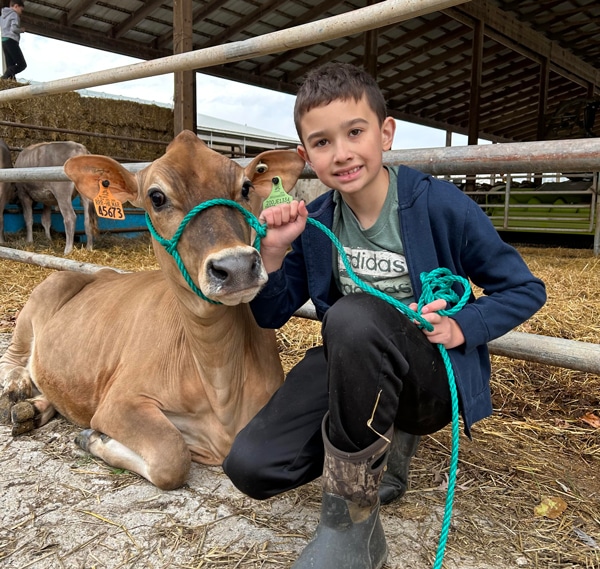
“The Pot O’Gold program is one of the coolest things we get to be a part of every year,” commented Ethan, who now serves on the sale committee. “That first sale in 2015 was the first time I sat down and looked at a sale catalog, dug into genetics to compare animals, and started going down to Louisville to look at them physically. That ignited my love for genetics.”
“We have had great success with the program, raised a ton of good animals, and even sent bulls to stud out of Pot O’Gold dams,” he continued. “We continue to grow those genetics and love to consign so we can contribute back to the program. Taking calves down to Louisville is one of my favorite things to do.”
“Today it is Colton and Brenden’s turn to invest in Pot O’Gold and 4-H animals with money they earn picking sweet corn during the summer,” Ethan said. “They are housed here and become part of our IVF program. My brothers get proceeds from bull and heifer sales to support them in future endeavors.”
One of Colton’s investments that has paid off is his purchase from the 2021 sale, JX Forest Glen Gislev Becky {5}-ET. Her granddaughter, Sand Creeks Stroud 17172-ET, ranked #1 for JPI after the April 2024 genetic evaluations. Her full sister, Sand Creeks Stroud 17164-ET, ranked #25.
“Having the #1 female in the breed was a first for us,” remarked Ethan. “She was high on our list because she had a unique pedigree and a different sire. Colton decided that was the one we would go with because he liked her.”
The Haywood family’s continued involvement with the Jersey breed is also driven by its people.
“When I got started, my dad and grandpa taught me a lot about farming and some about genetics,” Ethan noted. “But I have really learned very deeply about genetics through people in the Jersey industry. They helped us sort through a lot of those early Pot O’Gold lists, teaching me what I should be looking for. It was cool to have sire analysts from multiple companies on the phone telling me what to look for and teaching me in the process.”
Ethan also attributes the business’s success to a strong team of advisors, including a nutritionist, a group of veterinarians, the OPU vet, and financial consultants.
“We keep a pulse on everything on the farm, but their outside insight helps us make continuous improvements,” noted Ethan.
As Sand Creek Dairy, the foundation of the Jersey herd is built on rock-solid genetics. By fostering an exceptional environment, which includes first-class forages, the Haywood family has successfully leveraged these genetics to achieve high production and a strong market for dairy replacements and elite females and males.
Caption Feature Image: The Haywood family—(back) Devin, Ethan, Austin, Luke, Larry, (front) Brenden and Colton—focuses on growing and harvesting high quality forage for the herd at Sand Creek Dairy. Their forages have been recognized in the World Forage Analysis Superbowl and have contributed to a Jersey herd average ranked among the top 10 in the nation each of the past five years for at least one measure of production.
